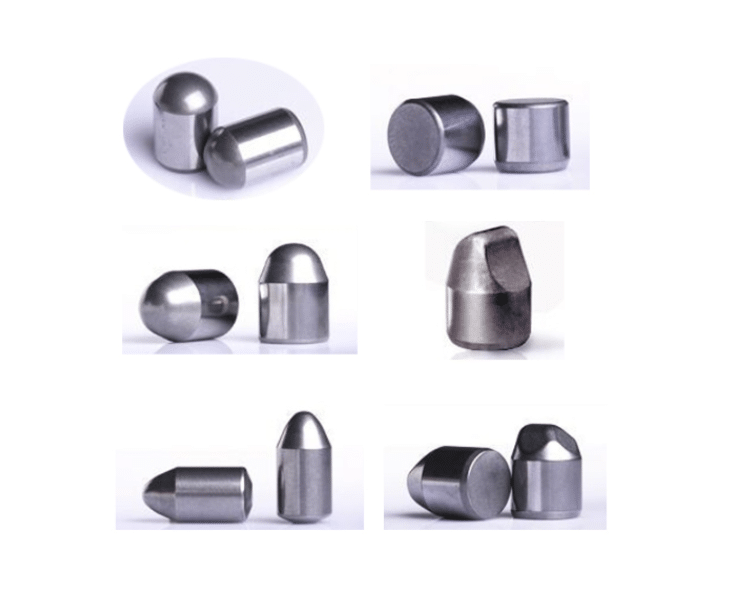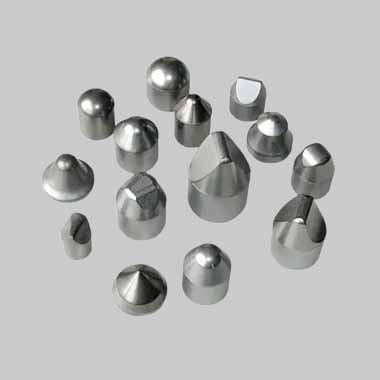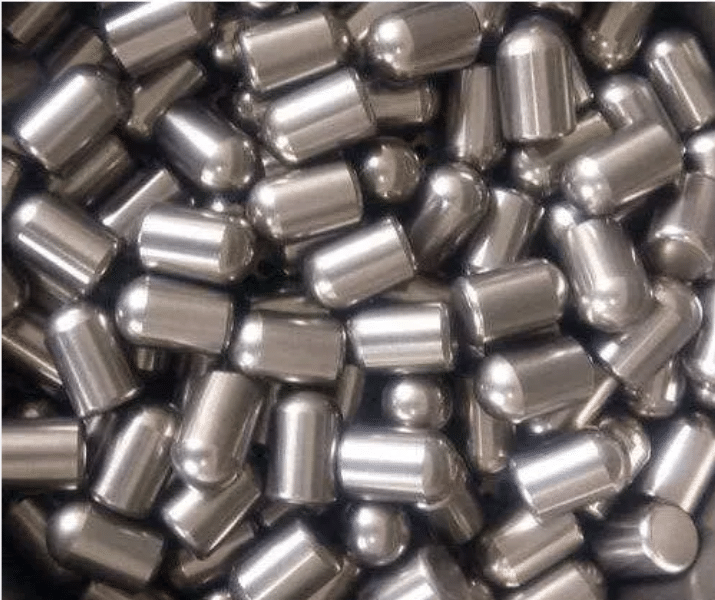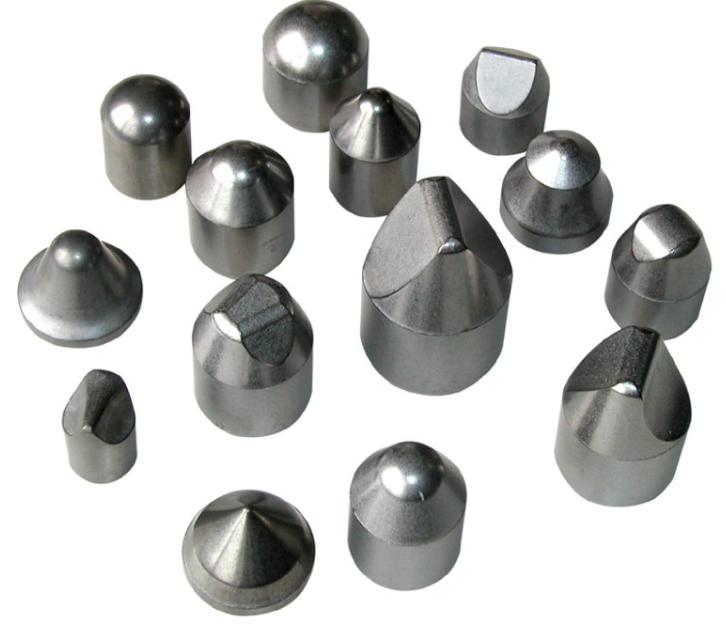Vue d'ensemble
Pointes brasées au carbure sont un composant essentiel des outils de coupe utilisés dans diverses industries. Ces pointes sont fabriquées en carbure de tungstène, connu pour sa dureté et sa résistance à l'usure exceptionnelles. Le processus de brasage consiste à assembler la pointe en carbure à un corps d'outil fabriqué dans un matériau différent, généralement de l'acier, à l'aide d'un métal d'apport. Cela permet d'obtenir une liaison solide capable de résister aux contraintes et aux températures élevées rencontrées lors des opérations de coupe.
Dans cet article, nous allons nous plonger dans le monde des pointes brasées en carbure, en explorant leurs types, leurs applications, les propriétés des matériaux, leur composition, etc. Nous vous donnerons également des indications sur la manière de sélectionner les pointes brasées en carbure les mieux adaptées à vos besoins spécifiques, et nous comparerons les différents produits disponibles sur le marché. C'est parti !

Types de pointes brasées au carbure
Aperçu détaillé des différents types de pointes brasées au carbure
En ce qui concerne les pointes brasées en carbure, il existe une grande variété de choix, chacun convenant à des applications et des matériaux spécifiques. Vous trouverez ci-dessous une présentation détaillée des types les plus courants de pointes brasées en carbure :
| Type d'embout brasé au carbure | Description |
|---|---|
| Conseils pour le grade C2 | Conçue pour la coupe, le fraisage et le tournage des métaux non ferreux et de la fonte. |
| Conseils pour le grade C5 | Convient pour les coupes difficiles et les coupes interrompues dans les matériaux plus durs comme les aciers alliés. |
| Conseils pour le classement de la C6 | Idéal pour les opérations de finition sur des matériaux plus durs, offrant une finition de surface fine. |
| K10 Grade Tips | Couramment utilisé pour couper des matériaux non métalliques, tels que le bois, les plastiques et les matériaux composites. |
| Conseils pour le grade P10 | Optimisé pour les applications en acier rapide (HSS), offrant des performances et une longévité accrues. |
| Conseils pour le classement du P20 | Pointes polyvalentes pour l'usinage général de l'acier et de la fonte à des vitesses de coupe modérées. |
| Conseils pour le grade M40 | Idéal pour l'usinage de l'acier inoxydable et d'autres alliages résistants, garantissant une usure minimale. |
| Conseils pour le classement du T15 | Conçus pour l'usinage à des vitesses extrêmement élevées, ils offrent une grande résistance à la chaleur. |
| Conseils pour le classement H10 | Spécialement conçu pour les applications nécessitant une ténacité et une résistance aux chocs élevées. |
| K20 Grade Tips | Offre d'excellentes performances dans les opérations de finition et de semi-finition sur les métaux durs. |
Applications des pointes brasées au carbure
Où sont utilisées les pointes brasées au carbure ?
Les pointes brasées en carbure trouvent des applications dans un large éventail d'industries en raison de leur durabilité et de leur efficacité. Le tableau ci-dessous présente quelques-unes des principales applications :
| Application | L'industrie | Exemple d'utilisation |
|---|---|---|
| Opérations de tournage et d'alésage | Automobile et aérospatiale | Usinage de pièces de moteur, telles que les pistons et les cylindres. |
| Opérations de broyage | Travail des métaux | Fabrication de pièces métalliques, telles que des supports et des cadres. |
| Perçage et alésage | Pétrole et gaz | Fabrication de tuyaux et de composants de têtes de puits. |
| Coupe et rainurage | Travail du bois | Fabrication de meubles et d'objets décoratifs en bois. |
| Façonnage et mise en forme | Plastiques et composites | Production de moules et de composants en plastique et en composite. |
| Découpe de profilés | Outil et matrice | Fabrication de matrices et d'inserts de moules complexes. |
| Coupe à usage intensif | Exploitation minière | Outils de coupe pour roches et minerais pour les équipements miniers. |
| Usinage de précision | Fabrication de dispositifs médicaux | Usinage de composants pour instruments chirurgicaux et implants. |
| Usinage à grande vitesse | Électronique | Création de composants et de boîtiers électroniques précis. |
| Usinage à usage général | Ingénierie générale | Production de diverses pièces et composants de machines. |
Propriétés matérielles des Pointes brasées au carbure
Comprendre les propriétés des matériaux
Les pointes brasées en carbure sont composées de matériaux offrant des propriétés spécifiques adaptées à différentes applications. Voici un aperçu des principales propriétés des matériaux :
| Propriété | Description |
|---|---|
| Dureté | La capacité à résister à l'usure de la surface et à la déformation sous haute pression. |
| Solidité | Capacité à absorber l'énergie et à résister à la rupture pendant l'usinage. |
| Résistance à l'usure | Résistance à la perte de matière due à l'abrasion lors des opérations de coupe. |
| Résistance à la chaleur | Capacité à conserver la résistance et la dureté à des températures élevées. |
| Résistance à la corrosion | Résistance à la dégradation chimique dans les environnements difficiles. |
| Conductivité thermique | La capacité de conduire la chaleur loin de l'arête de coupe, réduisant ainsi l'usure de l'outil. |
| Densité | La masse par unité de volume, qui affecte la résistance et la rigidité de l'outil. |
| Module d'élasticité | La mesure de la rigidité du matériau. |
| Coefficient de dilatation | La vitesse à laquelle le matériau se dilate ou se contracte en fonction des changements de température. |
| Conductivité électrique | Bien que moins critique pour les outils de coupe, il peut affecter certaines applications. |






Composition, propriétés et caractéristiques
Regarder de plus près la composition
Les performances des pointes brasées en carbure dépendent en grande partie de leur composition. Le tableau ci-dessous présente la composition typique et les caractéristiques associées :
| Composant matériel | Pourcentage Composition | Caractéristiques |
|---|---|---|
| Carbure de tungstène (WC) | 70-94% | Assure la dureté et la résistance à l'usure. |
| Cobalt (Co) | 5-20% | Agit comme un liant, offrant robustesse et résistance aux chocs. |
| Carbure de titane (TiC) | 1-10% | Améliore les performances de coupe dans les matériaux ferreux. |
| Carbure de tantale (TaC) | 1-5% | Améliore la résistance à la chaleur et la dureté. |
| Carbure de niobium (NbC) | 1-5% | Contribue à la stabilité à haute température et à la résistance à l'usure. |
| Carbure de vanadium (VC) | 0.5-2% | Augmente la dureté et la rétention des arêtes. |
| Carbure de chrome (CrC) | 0.5-2% | Offre une résistance à l'oxydation, améliorant ainsi la durée de vie des outils. |
| Nickel (Ni) | 0.5-2% | Ajoute une résistance à la corrosion et améliore la ténacité. |
Dureté, solidité et résistance à l'usure
L'importance de ces propriétés
La dureté, la solidité et la résistance à l'usure sont des facteurs essentiels qui définissent les performances des pointes brasées en carbure. Voici une comparaison de ces propriétés entre les différentes qualités :
| Grade | Dureté (HRA) | Résistance à la traction (MPa) | Résistance à l'usure |
|---|---|---|---|
| C2 Grade | 88-90 | 1370-1510 | Modéré |
| Catégorie C5 | 85-87 | 1450-1600 | Haut |
| Grade C6 | 90-92 | 1330-1480 | Très élevé |
| K10 Grade | 89-91 | 1400-1550 | Modéré |
| P10 Grade | 87-89 | 1350-1500 | Haut |
| P20 Grade | 86-88 | 1380-1530 | Modéré |
| Grade M40 | 88-90 | 1420-1570 | Très élevé |
| T15 Grade | 91-93 | 1300-1450 | Extrêmement élevé |
| Grade H10 | 86-88 | 1450-1600 | Haut |
| K20 Grade | 90-92 | 1370-1510 | Très élevé |
Spécifications, tailles, formes et normes
Obtenir le bon ajustement : Spécifications des pointes brasées au carbure
Pour choisir les bonnes pointes brasées en carbure, il faut tenir compte de diverses spécifications, notamment la taille, la forme et le respect des normes. Voici un guide complet :
| Spécifications | Détails |
|---|---|
| Tailles standard | Les pointes sont disponibles dans des tailles standard allant de 1/8″ à 2″ de largeur. |
| Options de forme | Formes carrées, triangulaires, rondes et personnalisées disponibles. |
| Gamme d'épaisseur | Elle est généralement comprise entre 0,05″ et 0,25″, en fonction de l'application. |
| Configuration des bords | Bords tranchants, chanfreinés ou arrondis pour répondre aux différents besoins de coupe. |
| Niveaux de tolérance | Tolérances strictes (±0,001″) pour garantir des ajustements précis et des performances optimales. |
| Normes industrielles | Conforme aux normes ISO, ANSI et DIN en matière de qualité et de cohérence. |
| Options de revêtement | Disponibles avec des revêtements tels que TiN, TiC ou diamant pour des performances accrues. |
Fournisseurs et détails des prix
Où acheter des pointes brasées au carbure et quel est le prix à payer ?
Il est essentiel de trouver un fournisseur fiable et de comprendre les prix des pointes brasées en carbure pour prendre des décisions d'achat éclairées. Vous trouverez ci-dessous une liste des principaux fournisseurs et de leurs tarifs :
| Fournisseur | Localisation | Gamme de produits | Fourchette de prix (par pourboire) |
|---|---|---|---|
| Kennametal | ÉTATS-UNIS | Large gamme de qualités et de tailles. | $5 – $25 |
| Sandvik Coromant | Suède | Pointes de haute performance pour des applications spécialisées. | $10 – $35 |
| Outils Seco | Suède | Pointes à usage général et pointes à grande vitesse. | $8 – $30 |
| Sumitomo Electric | Japon | Conseils avancés avec options personnalisées. | $12 – $40 |
| ISCAR | Israël | Pointes de précision pour les applications exigeantes. | $15 – $50 |
| Kyocera | Japon | Vaste choix à des prix compétitifs. | $7 – $28 |
| Tungaloy | Japon | Pointes à haute résistance à l'usure. | $9 – $32 |
| Outils Walter | Allemagne | Des pointes de qualité supérieure avec des solutions personnalisées. | $14 – $45 |
| Dépôt de carbure | ÉTATS-UNIS | Options économiques pour les applications standard. | $6 – $20 |
| Matériaux Mitsubishi | Japon | Pointes de haute précision pour les usinages complexes. | $10 – $38 |
Choisir le bon Pointes brasées au carbure
Comment choisir les meilleures pointes brasées au carbure pour vos besoins
Le choix des bonnes pointes brasées au carbure peut faire une différence significative en termes de performance et de rentabilité. Voici quelques éléments clés à prendre en compte :
| Considération | Explication |
|---|---|
| Matériau usiné | Différentes pointes sont optimisées pour différents matériaux ; choisissez en fonction du matériau spécifique avec lequel vous travaillez. |
| Vitesse de coupe | Les opérations à grande vitesse nécessitent des pointes à haute résistance à la chaleur, telles que les pointes de qualité T15. |
| Finition de la surface | Pour une finition de surface fine, optez pour des pointes comme C6 Grade conçues pour les opérations de finition. |
| Durée de vie de l'outil | Envisagez des pointes à haute résistance à l'usure, comme la qualité M40, pour prolonger la durée de vie de l'outil dans des conditions difficiles. |
| Coût et performance | Trouvez l'équilibre entre le coût et la performance en sélectionnant la qualité de pointe qui offre le meilleur retour sur investissement pour votre application. |
| Fiabilité des fournisseurs | Choisissez des fournisseurs réputés pour leur qualité constante et la fiabilité de leurs livraisons. |
| Conformité aux normes | Veiller à ce que les embouts soient conformes aux normes industrielles telles que ISO ou ANSI pour l'assurance qualité. |
| Besoins de personnalisation | Pour les tâches spécialisées, envisagez de faire appel à des fournisseurs qui proposent des formes et des tailles personnalisées. |
Avantages et limites des pointes brasées au carbure
Comparaison des avantages et des inconvénients
Les pointes brasées au carbure présentent leurs propres avantages et limites, et il est donc essentiel de tenir compte de ces facteurs lors du choix de l'outil le mieux adapté à vos besoins :
| Avantages | Limites |
|---|---|
| Dureté élevée et résistance à l'usure | Coût initial plus élevé que celui d'autres matériaux. |
| Excellentes performances dans les environnements à haute température | Des compétences spécialisées en matière de brasage peuvent être nécessaires pour une fixation correcte. |
| Polyvalence pour divers matériaux | Moins tolérant en termes d'impacts et de chocs, ce qui peut entraîner des fractures. |
| Durée de vie de l'outil plus longue | Disponibilité limitée dans certaines tailles et formes personnalisées. |
| Amélioration de l'efficacité de la coupe | Nécessite une configuration et un alignement précis pour des performances optimales. |

FAQ
| Question | Réponse |
|---|---|
| En quoi sont faites les pointes brasées au carbure ? | Ils sont principalement constitués de carbure de tungstène, de cobalt et d'autres carbures métalliques. |
| En quoi les pointes brasées en carbure diffèrent-elles des autres outils de coupe ? | Ils offrent une dureté plus élevée, une meilleure résistance à l'usure et peuvent supporter des températures élevées par rapport aux outils en acier rapide. |
| Les pointes brasées au carbure peuvent-elles être réaffûtées ? | Oui, mais le réaffûtage doit être effectué avec soin pour conserver la géométrie et le tranchant d'origine. |
| Quelle est la durée de vie typique d'une pointe brasée en carbure ? | La durée de vie varie en fonction du matériau usiné et des conditions de coupe, mais ils durent généralement plus longtemps que les outils HSS. |
| Comment savoir quelle qualité de pointe en carbure brasée utiliser ? | Choisissez la nuance en fonction du matériau à usiner, de la vitesse de coupe et de l'état de surface souhaité. |
| Y a-t-il des précautions particulières à prendre lors de l'utilisation de pointes brasées au carbure ? | Veiller au réglage et à l'alignement corrects de l'outil, utiliser les vitesses et les avances appropriées et porter un équipement de protection. |
| Quels sont les facteurs qui influencent le coût des pointes brasées en carbure ? | Les facteurs comprennent la qualité, la taille, la forme, le fournisseur et toute personnalisation requise. |
| Puis-je utiliser des pointes brasées en carbure sur des matériaux non métalliques ? | Oui, certaines qualités comme le K10 sont spécifiquement conçues pour les matériaux non métalliques. |
| Quel est le processus de brasage des pointes sur le corps de l'outil ? | Le brasage consiste à chauffer le métal d'apport pour lier la pointe en carbure au corps de l'outil, assurant ainsi un joint solide et durable. |
| Où puis-je acheter des pointes brasées en carbure de haute qualité ? | Les fournisseurs réputés sont notamment Kennametal, Sandvik Coromant et ISCAR. |
Conclusion
Pointes brasées au carbure sont une pierre angulaire de l'industrie de l'usinage, offrant une dureté, une résistance à l'usure et des performances inégalées dans toute une série d'applications. Comprendre les différents types, les applications, les propriétés des matériaux et la manière de sélectionner la pointe adaptée à vos besoins peut avoir un impact significatif sur l'efficacité et la rentabilité de vos opérations. Que vous travailliez le métal, le bois ou les matériaux composites, le choix de la bonne pointe brasée en carbure peut faire toute la différence pour obtenir des résultats optimaux.
N'oubliez pas de tenir compte de tous les facteurs évoqués dans cet article, de la composition des matériaux à la fiabilité des fournisseurs, et veillez à utiliser des astuces conformes aux normes industrielles pour obtenir les meilleurs résultats. Avec les connaissances et les outils adéquats à votre disposition, vous êtes bien équipé pour relever tous les défis d'usinage qui se présentent à vous.




